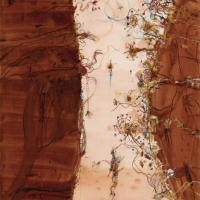78. JOHN OLSEN

At a certain point the lake turns all crimson coloured. It becomes too salty. Theres millions of fish just lying on the edge, dead pelicans There it is and there it isnt.1
Edge of the Void 2009 shows the acclaimed Australian artist John Olsen at his erudite best. Painted in his eightieth year, this large work on paper contains all the elements that have contributed to a long and illustrious career. Edge of the Void is a bold composition with an emphasis on flat shapes, sheer edges, and snaking lines. Olsen portrays a natural environment as a dynamic and interconnected entity. For Olsen, the Australian landscape is teeming with life and vitality. His role is to translate the inexorable excitement and joy of being in front of one of his favourite subjects, Lake Eyre.
John Olsens love of travel and adventure is well known. Whether in Australia or during long stints abroad, Olsen is legendary in seeking out new and exciting places. He often travels to the extremities in search of fresh subject matter and gives new perspective to ancient formations and distinctive lands.
Lake Eyre is a remote salt lake in Central Australia, approximately six hundred kilometres north of Adelaide. In October 1973, extraordinarily heavy rains in the north spread immense volumes of water southward, subsuming the normally dry lake. As the water rose, so the lake became a teeming mass of life. Multitudes of fish, frogs, insects, and birds suddenly emerged. However, the water receded soon after, eventually leading to the demise of all that had sprung to life.
John Olsen first visited Lake Eyre in late 1974, in the company of Vincent Serventy, the distinguished Australian author, ornithologist and conservationist. It was Olsens first contact with the central Australian landscape. The flooding and the miracle of life, followed by the drawn-out death of wildlife had a long and far-reaching effect on Olsen. Lake Eyre 1975 (private collection) and a large gouache drawing Edge of the Void 1975 (private collection) are among the first paintings that record Olsens profound response to the transformation of the lake. Dark Void 1976, another major early painting, was produced soon after. This companion work explored the end of the cycle and the return of Lake Eyre to its former state.
Edge of the Void 2009 adapts elements of the three iconic 1970s paintings to create an entirely new iteration of the Lake Eyre flood. Olsen shows the sodden lake and major tributary as it dries out. To create this transition, Olsen makes use of a bold, visual device that he learnt from traditional Chinese painting. By tilting the picture plane, he was able to look both down and through the landscape. Water filters across two facing cliffs as if seen from above while the muddy banks with fish and insects fight tenaciously for life at close quarters.
Edge of the Void reinforces John Olsens long-held fascination with Buddhism and the idea of impermanence and the benign concept of nothingness (the void). It is inevitable that in this large and impressive work that everything is returning to its former state. The tantalising, spidery lines that reach rhizome-like into the surrounding space will curl, wither, and die. Until, at least, the next time the water arrives.
Footnotes:
1. John Olsen: The You Beaut Country Exhibition Labels, National Gallery of Victoria, Melbourne, 2017 (accessed October 2022): https://www.ngv.vic.gov.au/wp-content/uploads/2016/04/JohnOlsen_ArtworkLabels.pdf
Rodney James
Rodney James is an independent art consultant who specialises in valuations, collection management, exhibitions, research and writing, and strategic planning for art galleries and museums.